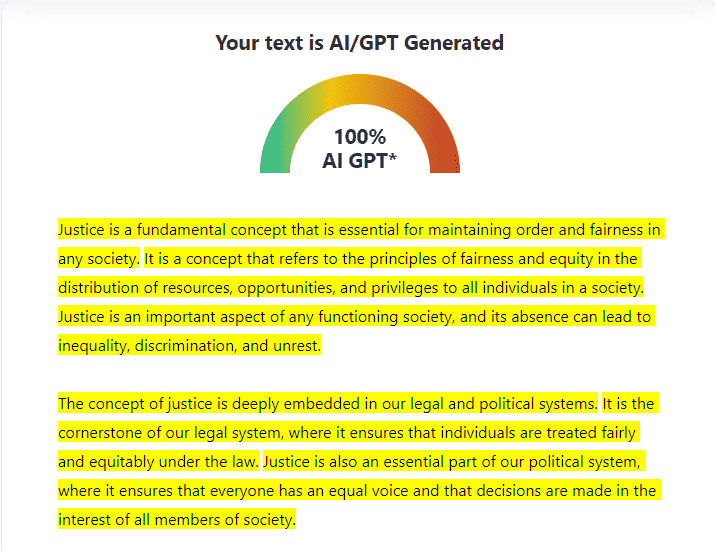AI Detector: Tools and Techniques for Identifying Artificial Intelligence Work
AI Detector: Tools and Techniques for Identifying Artificial Intelligence Work
Blog Article
Recognizing the Value of an Ai Detector in Today's Digital Landscape
As man-made knowledge continues to penetrate numerous facets of content production, distinguishing between machine-generated and human-generated product has actually become increasingly complex. These instruments not only aid in determining AI-produced material however additionally promote the integrity of details circulation.
The Surge of AI Web Content

The surge of AI-generated material has considerable implications for various industries, consisting of enjoyment, journalism, and advertising - ai detector. Organizations are increasingly making use of these innovations to enhance efficiency, personalize web content, and engage target markets much more effectively. The capability to analyze substantial datasets allows AI systems to customize content to fulfill particular user preferences, providing an extra individualized experience
However, the spreading of AI material additionally raises important considerations for web content developers and customers alike. As AI becomes a lot more incorporated into material manufacturing workflows, comprehending the subtleties of AI-generated product is vital for keeping quality and significance in a swiftly developing electronic setting. Embracing this technological improvement while continuing to be vigilant about its effects is important for stakeholders in the digital media landscape.
Challenges of Credibility
The emergence of AI-generated content has introduced considerable obstacles concerning credibility in electronic media. As algorithms come to be more sophisticated, comparing machine-generated and human-created web content becomes increasingly challenging. This blurring of lines raises issues regarding the reputation of details and the possibility for false information to proliferate.
One of the primary challenges is the disintegration of trust among consumers. With AI with the ability of generating practical message, images, and video clips, people might locate it testing to discern genuine sources from deceptive ones. This uncertainty can bring about a more comprehensive skepticism of all electronic material, complicating initiatives to recognize reputable information.
Moreover, the ramifications for copyright are significant. As AI tools generate web content based on existing works, inquiries relating to ownership and originality occur. Content creators might have a hard time to safeguard their work from anonymous AI reproductions, threatening their legal rights and incomes.
Lastly, the potential for destructive uses of AI-generated material, such as deepfakes and automatic publicity, postures significant honest and societal risks. These obstacles highlight the urgent need for structures that support credibility in the digital landscape, ensuring that details stays credible and reliable.
Function of AI Detectors
Attending to the obstacles of authenticity in electronic media requires cutting-edge options, and AI detectors have actually become a vital tool in this initiative. These technologies are developed to assess and identify material produced by artificial intelligence, thus assisting in the discernment between machine-generated and human-created products. The role of AI detectors expands past mere identification; they also add to maintaining the integrity of details taken in by the public.
AI detectors utilize advanced algorithms to scrutinize different components of electronic web content, including etymological patterns, architectural abnormalities, and details pens that show automation. Their application spans several fields, consisting of journalism, education and learning, and social media sites, where the existence of AI-generated content can cause false information and erosion of count on.
Advantages of Utilizing AI Detectors
Making sure authenticity in electronic content embodies the basic need for trust fund in info resources, and AI detectors function as an effective ally in this pursuit. By recognizing AI-generated content, these tools aid preserve the honesty of information, consequently shielding users from false information and improving total content quality.
Among the main advantages of making use of AI detectors is their ability to improve content verification processes, dramatically minimizing the moment and effort needed to assess the credibility of electronic products. This efficiency enables material creators, teachers, and organizations to focus on producing high-grade and reputable info, More about the author instead than spending too much sources on fact-checking.
Furthermore, AI detectors foster responsibility amongst material makers. The expertise that AI-generated content can be identified encourages transparency and honest techniques in content production. This, in turn, adds to visit their website a more informed digital community, as users can confidently engage with verified information.
Future of Content Verification
As the landscape of digital material remains to develop, the future of content verification challenges both provides and possibilities for maintaining authenticity. As AI innovations breakthrough, so also do the techniques for sharing and developing misinformation (ai detector). This arms race in between material makers and verification tools requires the advancement of extra sophisticated AI detectors efficient in discerning authentic material from controlled or fabricated product

In addition, the surge of decentralized modern technologies, such as blockchain, holds assurance for verifying material provenance, ensuring that individuals can map the origins of the info they eat. Eventually, the future of web content verification will depend upon our capacity to innovate when faced with advancing risks, cultivating a digital atmosphere where credibility is recognized and maintained as a basic principle.
Final Thought
In conclusion, the expansion of AI-generated content demands durable mechanisms for authenticity verification. The future of content confirmation hinges on the performance of AI detectors in maintaining reputation across different media systems.
AI content development devices, such as natural language processing designs and generative adversarial networks, enable organizations and people to produce top quality material at extraordinary speeds and lower expenses.
Nonetheless, the proliferation of AI content likewise raises important factors to consider for content creators and customers alike. As the refinement of AI-generated material continues to develop, the function of AI detectors comes to be significantly vital in protecting authenticity and promoting openness in electronic interaction. The expertise that AI-generated web content can be recognized linked here urges openness and ethical techniques in material manufacturing.As the landscape of digital content continues to evolve, the future of material verification offers both challenges and chances for maintaining credibility.
Report this page